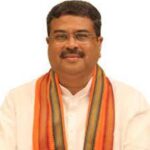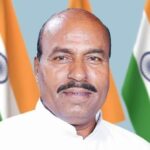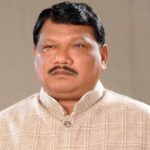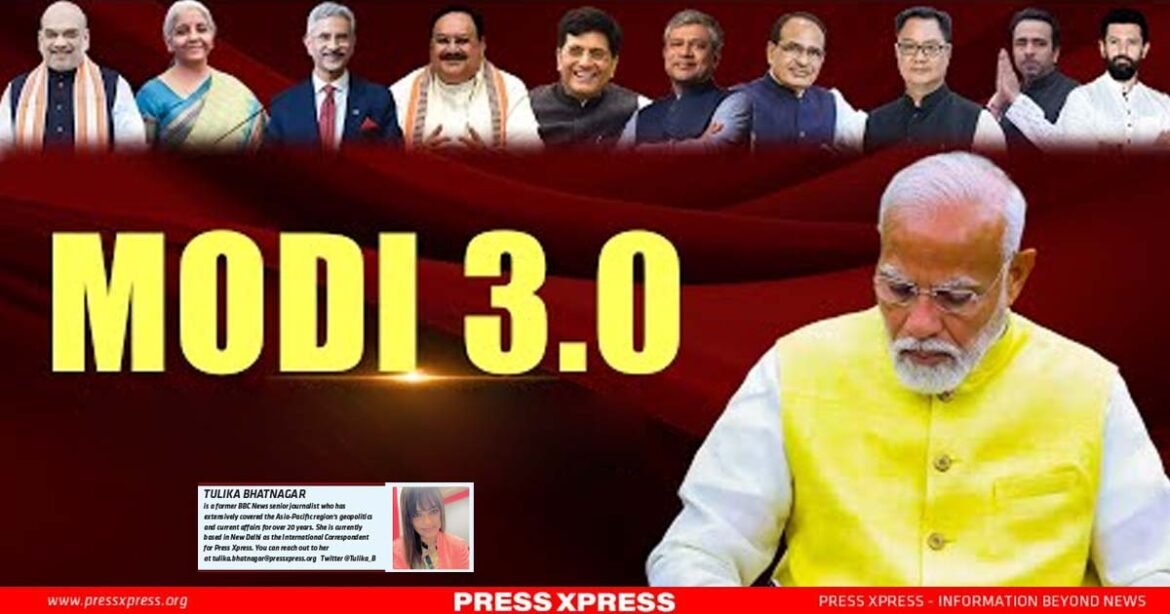Indian Prime Minister Narendra Modi has unveiled his new Cabinet with 71 members of his coalition government taking oath of office in a grand ceremony on 9 June.
A day later, Modi has assigned crucial portfolios to these ministers, setting the direction for India’s new governance for the next five years.
Out of 71 posts, 60 have gone to the Bharatiya Janata Party (BJP), which secured 240 seats – the highest – in the recently concluded Lok Sabha elections. The remaining 11 posts have been distributed among BJP’s allies that together constitute the National Democratic Alliance (NDA) umbrella.
Old guard, new faces
The new Modi 3.0 Cabinet is a mix of new faces and the old guard – some of them retaining their old ministries, highlighting Modi’s preference for policy continuity.
The influx of fresh, new faces – some very young – also indicates an inclusive approach, showcasing a foundation of trust in the Modi 3.0 coalition government.
In allocating portfolios to the ministers, Modi has largely retained his top lieutenants.
The four big ministries remain the same as the previous term: Amit Shah is in charge of the Home Ministry; Rajnath Singh leading the Defence Ministry; Nirmala Sitharaman retaining the Finance Ministry; and, S Jaishankar continuing to lead the Ministry of External Affairs.

Additionally, the key infrastructure ministries are also with key BJP leaders, who continue to retain these from previous terms.
Railways, Shipping & Ports, Road Transport and Highways, and Telecom are all with BJP. Telecom has gone to a new leader, while Aviation has gone to an ally, the Telugu Desam Party (TDP).
Here is the list of who’s who of the infrastructure ministries:
- Road Transport and Highways: Nitin Gadkari
- Shipping & Ports: Sarbananda Sonowal
- Railways: Ashwini Vaishnaw
- Telecom: Jyotiraditya Scindia
- Aviation: Ram Mohan Naidu
In addition to Railways, Vaishnaw also has secured the charge of Information Technology and Information and Broadcasting.
Team NDA 3.0
Among the allies of the BJP within the NDA, these are the portfolios they have secured:
Ally: Apna Dal (Soneylal) or ADAL
- Minister of State: Anupriya Patel
Portfolio: Health & Family Welfare; Chemicals & Fertilizers
Ally: Hindustani Awam Morcha (Secular) or HAM (S)
- Cabinet Minister: Jitan Ram Manjhi
Portfolio: MSME
Ally: Janata Dal (Secular) or JD (S)
- Cabinet Minister: HD Kumaraswamy
Portfolio: Heavy Industries & Steel
Ally: Janata Dal (United) or JD (U)
- Cabinet Minister: Rajiv Ranjan Singh (Lalan Singh)
Portfolio: Panchayati Raj; Fisheries, Animal Husbandry and Dairying
Ally: Janata Dal (United) or JD (U)
- Minister of State: Ram Nath Thakur
Portfolio: Agriculture and Farmers’ Welfare
Ally: Lok Janshakti Party (Ram Vilas) or LJP (RV)
- Cabinet Minister: Chirag Paswan
Portfolio: Food Processing Industries
Ally: Rashtriya Lok Dal or RLD
- Minister of State with Independent Charge: Jayant Chaudhary
Portfolio: Skill Development; Education
Ally: Republican Party of India or RPI
- Minister of State: Ram Das Athawale
Portfolio: Social Justice and Empowerment
Ally: Shiv Sena or SS
- Minister of State with Independent Charge: Prataprao Jadhav
Portfolio: Ayush; Health & Family Welfare
Ally: Telugu Desam Party or TDP
- Cabinet Minister: Ram Mohan Naidu
Portfolio: Civil Aviation
Ally: Telugu Desam Party or TDP
- Minister of State: Chandra Sekhar Pemmasani
Portfolio: Rural Development; Communications
All of the other remaining portfolios are with the BJP.
Here is a look at what those positions are and who has secured them within the BJP.
What’s with the Prime Minister?
PM Narendra Modi has kept the following portfolios with him:

Narendra Modi
• Ministry of Personnel, Public Grievances and Pensions
• Department of Atomic Energy
• Department of Space
• All important policy issues
• All other portfolios not allocated to any Minister
Who are the remaining Cabinet Ministers & what are their portfolios?

JP Nadda
o Health and Family Welfare
o Chemicals and Fertilizers

Shivraj Singh Chouhan
o Agriculture and Farmers Welfare
o Rural Development

Manohar Lal
o Housing and Urban Affairs
o Power

Piyush Goyal
o Commerce and Industry

Dharmendra Pradhan
o Education

Dr Virendra Kumar
o Social Justice and Empowerment

Jual Oram
o Tribal Affairs

Giriraj Singh
o Textiles

Bhupender Yadav
o Environment, Forest and Climate Change

Gajendra Singh Shekhawat
o Culture
o Tourism

Annpurna Devi
o Women and Child Development

Kiren Rijiju
o Parliamentary Affairs
o Minority Affairs

Dr Mansukh Mandaviya
o Labour and Employment
o Youth Affairs and Sports

G Kishan Reddy
o Coal
o Mines
Additionally, there are other ministers of state as well as ministers of state with independent charge.
For the complete list, click here
Profile of the latest Lok Sabha
It is interesting to note that this year, as many as 52% of Lok Sabha has first-time members of the parliament (MPs). Among the notable first-time MPs are: Actor Arun Govil from Uttar Pradesh, Bollywood star Kangna Ranaut from Himachal Pradesh, and cricketer Yusuf Pathan from West Bengal.

According to data by PRS Legislative Research, the latest 18th Lok Sabha has candidates from 41 political parties across India elected after the Lok Sabha election 2024.

However, the Indian parliament seems to be getting older. The average age of MPs in the latest Lok Sabha, is 56 years. The oldest MP is 82 years old, while the youngest is 25.
In terms of gender profile, only 14% of elected MPs are women. In comparison, women MPs constitute 46% of the parliament in South Africa, 35% in the UK, and 29% in the US.
Agriculture (37%) and social work (48%) appear to be the main professions of the elected MPs. Only 3% have declared their profession as teachers, 4% as medical practitioners, and 7% as lawyers or judges.
<pl make infographic on above data. Here is a link for reference: https://prsindia.org/files/parliament/vital_stats/Profile-18th_LS.pdf >
What happens next?
The countdown for the first 100 days of Modi 3.0 has already begun.
PM Modi has asked all Union Ministries to finalize their 100-day action plans.
Modi himself kicked off the new term by signing the Kisan Nidhi scheme (cash benefits to farmers) and Pradhan Mantri Awas Yojana (PMAY), an affordable housing scheme.
Among the most important announcements that the stock market will be watching closely is also the economic roadmap for the next year. The first annual budget of Modi 3.0 government will be presented early next month.
It is expected that there will be fast-track reforms to achieve India’s target of becoming a $5 trillion economy and become a developed economy by 2047.
The key priorities for the new government would be to address job creation, an important voter sentiment even during the election.
Additionally, a crucial action plan would be to hold assembly polls in Jammu & Kashmir and resolve Manipur’s ethnic conflict.
On the global stage, PM Modi will be attending the G7, SCO, and BRICS summits, and is also likely to attend Bimstec, G20, and Asean-East Asia summits.
Internally, the BJP is also expected to revamp its structure.
BJP president JP Nadda’s term ends in June and he is also included in the new Council of Ministers. Therefore, BJP will go for an overhaul of its organisational structure, and look for a new party chief.


